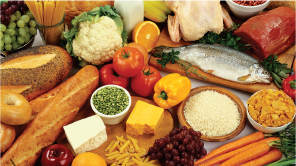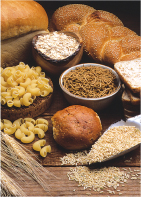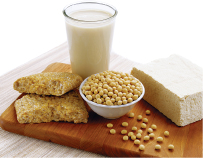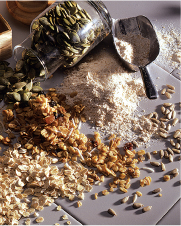What causes food allergies?
In treating food allergies, the first step is finding out what foods you are allergic to, keeping in mind that many times they may be several. Food and allergic reactions vary from person to person. Next, you should find a nutritional substitute to make sure that you keep a balanced, healthy diet.

NOTE
You should always consult your doctor before changing your diet.
+ A food allergy occurs when your immune system responds defensively to a specific food that is not harmful to most people. When you eat the offending food, your immune system responds by creating specific disease-fighting antibodies that release large amounts of histamine in an effort to expel the “foreign invader” from your body. Histamine is a powerful chemical that can affect the respiratory system, gastrointestinal tract, skin or cardiovascular system. Although vary rare, there are a number of food allergies that can cause death (such as asphyxia). The most common food allergies are in reaction to:
- • wheat and wheat derived foods;
- • dairy products;
- • eggs;
- • peanuts;
- • shell fish;
- • some types of fish;
- • nuts and dried fruits;
- • soy beans;
- • yeast;
- • chocolate.

HOW ARE FOOD ALLERGIES DIAGNOSED?
Knowing what food causes allergy is not simple, only a few people have allergies to just one food. Also, allergic reactions can vary and are not always immediate. There are a number of tests to diagnose allergens, they vary from specialist to specialist. It's important that you research the possible tests and find out from your specialist what tests are best for you.
First test
If you suspect that a certain food causes your allergic reaction, it's recommended to cut that food from your diet for 10 days, observing any changes in your body. If the symptoms diminishes or disappear, you will need to completely eliminate that food from your diet. If you don't notice any change or if your symptoms continue, it's important to consult an allergist or specialist to diagnose your allergy through precise tests.
UNLIKELY FOOD ALLERGIES
Rice, sunflower and olive oils, sweet potatoes, broccoli, cauliflower, rabbit, peaches, pears and carrots.

The most susceptible, children
Little ones, especially babies, are more susceptible than adults to food allergies. It's estimated that one in ten children suffer from an allergy, although eight out of ten children with this ailment tend to get over the problem before they are five years of age. Among the most frequent causes are formulas, derived from cow's milk, that substitute mother's breast milk. In addition, milk and eggs tend to be the cause of eczema in children. It's important that babies don't eat any foods containing gluten (most cereals) for the first six months, because they haven't developed the enzymes to digest this protein. The same goes for honey, which should be avoided for the first year of life.

DAIRY ALLERGIES
Dairy products can act as allergens, especially for small, breast-feeding children. A reaction can be so severe as to cause bronchial spasms and asthma attacks. This may be due to a type of protein found in milk that is difficult for little ones to break down and introduce into the body, because it contains a chemical structure designed for a calf, which weighs 287 lb/130 kg. When compared to a baby's size, 7 to 22 lb/3 to 10 kg, it's understandable why children easily suffer from allergies to cow's milk. In the case of an allergic reaction it may be convenient to avoid dairy products (pure milk as well as powdered milk or other formulas) and replace them with sesame, soy, coconut or almond milk. Studies have also shown that children may be less allergic to goat's milk.
Warning. Chicken eggs can also be allergenic.
FOR PROPER CALCIUM INTAKE
Eliminating milk and other dairy products from the diet can bring on a calcium deficiency. To avoid this, you can substitute daily, always consulting your physician before:
- • Soy or sesame milk. 1 glass or cup (preferably organic). Almond milk is also recommended.
- • Wholegrain cereals. 1 small bowl (2 oz/60 g uncooked)
- • Vegetables. 2 full plates, if possible raw.
- • Fruit (seasonal fruit). 3 portions.
- • Bread (wholewheat). 4 slices.
- • Beans. 1 tablespoon (or 1 full plate once a week).
- • Tofu (soy cheese). 2 tablespoons.
- • Granola. 1 cup, to substitute 2 slices of bread, if you're on a diet.
- • Soy. Flour, beans or patties (in this case, twice a week).
- • Nuts. 12 almonds or hazelnuts.
- • Sesame (whole). 2 teaspoons.
- • Poppy seeds. 1 teaspoon.
- • Brewer's yeast. 2 tablespoons.

BE CAREFUL WITH LABELS
“Non-diary” on labels means that the product doesn't contain butter, cream or milk.
However, this label doesn't necessarily mean that the food doesn't include other ingredients derived from milk. This is why it's important to carefully read all the ingredients on the label. Processed meats, including hot dogs and other deli meats tend to have milk and other dairy products added.
Other foods that can contain milk:
- • Foods with black sugar.
- • Foods containing caramel.
- • Chocolate.
- • High-protein flour.
- • Margarine.
Wheat allergies

Allergic reaction to wheat is an abnormal response in the body against the protein found in this food. There is an infinite number of products made with this grain, in order to identify and avoid wheat it's important to carefully read all food labels. People with wheat allergies should not eat any product that contains: bread crumbs, whole grains, cereal extract, couscous, salted crackers, wheat flour (especially high protein, enriched with gluten), wheat gluten, malt or wheat starch. Wheat can also be found in: starch gelatin, dehydrated vegetable protein, starches, and vegetable gums.
To substitute wheat in a number of recipes, keep in mind equivalents and portions. 1 cup of wheat flour is equivalent to:
- • 1 cup of rye flour.
- • 1 cup of potato flour.
- • 1 1/3 cups of oat flour.
- • ½ cup of potato flour + ½ cup of rye flour.
- • 5/8 cup of potato starch.
- • 5/8 cup of rice flour + 1/3 cup of rye flour.
WHEAT FREE DIET
Breakfast and snack
Fruit or vegetable juice. Seeds. Rice cakes with cream cheese and/or honey.
Or yogurt with sesame seeds or homemade crackers with oatmeal, honey and raisins.
Mid morning
Fruit (fresh or dried).

Lunch and dinner
Rice noodles or brown rice with vegetables.
Lean meat, skinless chicken, fish, accompanied by vegetables and 1 egg.
Lentils, beans, peas, chickpeas with vegetables.
Tart made with a homemade dough, made from rice and oat flour.
Fruit.
Gluten allergy
People who are allergic to gluten have trouble absorbing these nutrients because gluten proteins harm the small intestine's lining. This provokes an allergic reaction with symptoms of bloating, anaemia, diarrhea and weight loss.
Gluten is found in grains such as wheat, rye, barley and oat, which should be completely avoided. To keep a balanced diet you should eat plenty of:
- • Fresh fruit and vegetables.
- • Gluten free cereals such as quinoa.
- • Eggs, milk, cheese, meat, chicken and fish are also valid alternatives.

Peanut allergies
Peanuts are very allergenic and can cause fatal reactions if ingested by people with allergies to certain proteins found in peanuts. You need to carefully read all food labels to make sure that the food doesn't contain any of the following ingredients.
- • Peanut oil.
- • Ground nuts.
- • Mixed nuts.
- • Peanut butter.
- • Peanut flour.
You should also keep in mind that some ethnic foods and some industrially processed or cooked foods, candies or soft drinks can contain peanuts and derivatives.

Comment about this article, ask questions, or add new information about this topic: